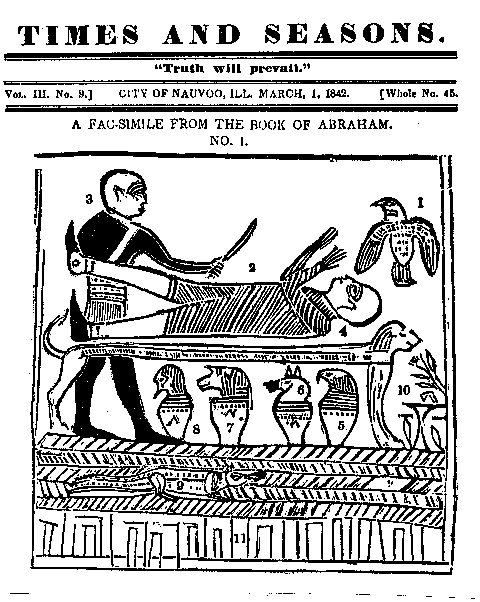
Discussion by Jeff Lindsay
Thumbs and Lion Couches by Kerry Shirts
Uniqueness of Facsimile #1 by Kerry Shirts
A

|
|
|
|
|
|
|

The Angel of the Lord |
||
|
|
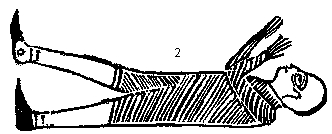
Abraham fastened on the altar |
Abraham or Osiris by Kerry Shirts
Abraham's Garment by Kerry Shirts |
|
|
|
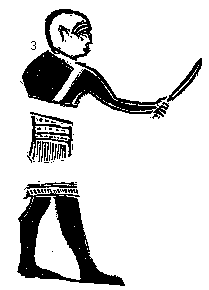 The idolatrous priest of
Elkanah attempting to offer up Abraham as a sacrifice. The idolatrous priest of
Elkanah attempting to offer up Abraham as a sacrifice. |
||
|
|
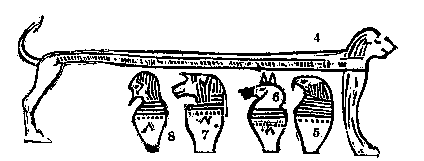
The altar for sacrifice by the idolatrous priest, |
||
|
|

The idolatrous god of Elkenah |
Son's of Horus by Kerry Shirts | |
|
|

The idolatrous god of Libnah |
Son's of Horus by Kerry Shirts | |
|
|

The idolatrous god of Mahmackrah |
Son's of Horus by Kerry Shirts | |
|
|

The idolatrous god of Karash |
Son's of Horus by Kerry Shirts | |
|
|
The idolatrous god of Pharaoh |
Unas or Wenis, for example, was the last king of the fifth dynasty
(circa 2356–2323 B.C.), and his pyramid still stands at Saqqara, south
of modern Cairo. Utterance 317 of Unas’s Pyramid Texts includes the following:
“The King Appears as the Crocodile-God Sobk,” (Miriam Lichtheim, Ancient
Egyptian Literature: A Book of Readings, 3 vols (Berkeley: University
of California Press, 1975-80), 1:40)
One scholar observes that “the god Sobk is … viewed as a manifestation of Horus, the god most closely identified with the kingship of Egypt” during the Egyptian Middle Kingdom era (circa 2040–1640 B.C.), which includes the time period that tradition indicates as Abraham’s lifetime. (Lichtheim, Ancient Egyptian Literature, 1:201) [from Ensign Jan, 1994, News from Antiquity, Daniel Peterson] |
Crocodile God by John Gee |
|
|
 Abraham in Egypt Abraham in Egypt |
||
|
|

Designed to represent the pillars of heaven |
||
|
|
 Raukeeyang, signifying expanse
or the firmament over our heads; but in this case the Egyptians meant it
to signify Shaumau, to be high, or the heavens, answering to the Hebrew
word, Shaumahyeem. Raukeeyang, signifying expanse
or the firmament over our heads; but in this case the Egyptians meant it
to signify Shaumau, to be high, or the heavens, answering to the Hebrew
word, Shaumahyeem. |
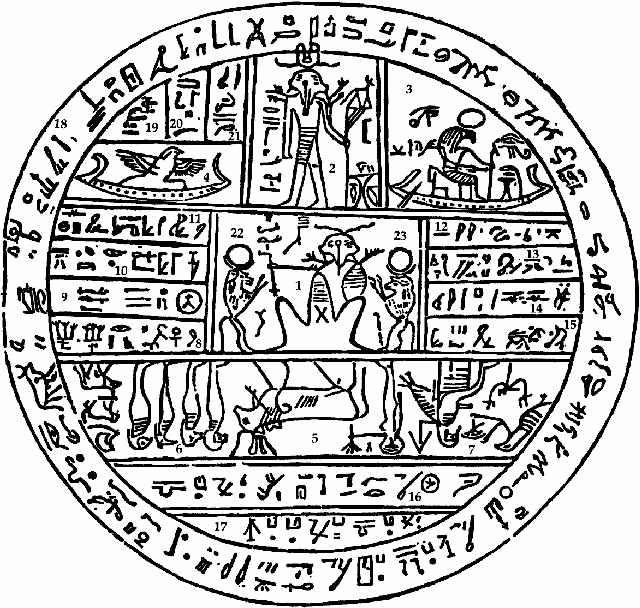
|
|
|
|
|
|
|
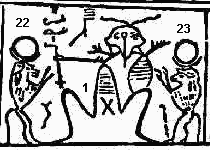
Kolob, signifying the first creation, nearest to the celestial, or the residence of God. First in government, the last pertaining to the measurement of time. The cubit, one day in Kolob is equal to a thousand years according to the mesaurement of this earth, which is called by the Egyptians Joh-oh-eh. . . the stars represented by numbers 22, and 23, receiving light from the revolutions of Kolob. |
1. A seated deity with two (or in most hypocephali, four) ram's heads.
He is holding in his hand the symbols of life (cnh),
dominion (w3s) and stability (dd). On either side of the
god are two apes (numbers 22 and 23) with horned moon-disks on their heads,
in an attitude of adoration. There are also two serpents, one on either
side of the seated deity. The god is sitting at the center of the hypocephalus,
which, as was mentioned above, represents the world.
This seated figure represents god as the creator, either Amon-Re or Khnum. When thus depicted with four heads, this god united within himself the attributes of the gods Re (the sun), Shu (light), Geb (the earth), and Osiris (god of the next world and the resurrection), and represented the primeval creative force. This agrees well with the Egyptian symbolism of god endowed with the primeval creative force seated at the center of the universe. The name Kolob is right at home in this context. The word most likely derives from the common Semitic root QLB, which has the basic meaning of "heart, center, middle" (Arabic qalb "heart, center"; Hebrew qereb "middle, midst", qarab "to draw near"; Egyptian m-q3b "in the midst of"). In fact, qalb forms part of the Arabic names of several of the brightest stars in the sky, including Antares, Regulus, and Canopus. The apes can represent Thoth, the god of writing and wisdom, as well as the moon, but due to their curious habit of holding up their hands to receive the first warming rays of the sun after the cold desert night as if worshiping the sun at its rising, they are often found in connection with the sun. Besides these solar and lunar associations, apes are also found associated with stars and constellations. Joseph Smith says they are stars receiving light from Kolob, which is in harmony with our understanding of their symbolism in Egyptian. In the Times and Seasons he defined Jah-oh-eh as "O the Earth." This would be reasonable rendering of the Egyptian i 3h.t, "O Earth" (assuming that Joseph used the biblical convention of rendering a Semitic yod with an english J. |
Chnum-Re by Kerry Shirts
The Joseph Smith Hypocephalus Seventeen Years Later, by Michael D. Rhodes |
|
|
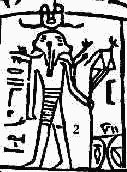
Stands next to Kolob, called by the Egyptians Oliblish, which is the next grand governing creation near to the celestial or the place where God resides; holding the key of power also, pertaining to other planets; as revealed from God to Abraham, as he offered sacrifice upon an altar, which he had built unto the Lord. |
A two-headed deity wearing the double-plumed crown of Amon, with ram's
horns mounted on it. On his shoulders are jackal heads, and he is holding
the jackal standard of the god Wepwawet. To his right is an altar with
offerings on and around it. In most hypocephali, he is holding the ankh,
or symbol of life, in his right hand. Also to his right is a line of hieroglyphs
reading: "The name of this Mighty God."
This is Amon-Re, the chief god of the Egyptian pantheon; the two heads illustrate the hidden and mysterious power of Amon (his name in Egyptian means "the Hidden One") combined with the visible and luminous power of Re. This is clearly the god mentioned in chapter 162 of the Book of the Dead (the chapter describing the construction and use of the hypocephalus), who wears the double plumed crown. The jackals on his shoulders as well as the jackal standard he holds are symbols of the god Wepwawet, the Opener of the Way, i.e. of the year, of the king in his conquests, of the dead through the dangers of hereafter to the throne of Osiris where they would be judged, or any other way that needs opening. The symbol of life held by this god was considered as a symbol of a god's power. A good example is the god Aton, who is represented by a sun disk with numerous rays emanating from it that all end in a hand holding the symbol of life. I can find no obvious word in Egyptian that matches with Oliblish, but this puts it in the same category as many of the strange names found in the 162nd chapter of the Book of the Dead, which seem not to be Egyptian but some foreign language. Joseph also says this figure pertains to the plan of God's creations as revealed to Abraham as he was making a sacrifice. This agrees exactly with the Apocalypse of Abraham account as described above, as well as with the Egyptian concept of the hypocephalus representing all that the sun encircles. |
The Joseph Smith Hypocephalus Seventeen Years Later, by Michael D. Rhodes |
|
|
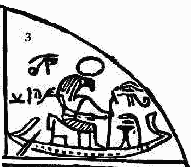
Is made to represent God, sitting upon his throne, clothed with power and authority; with a crown of eternal light upon his head; representing also the grand Key-words of the Holy Priesthood, as revealed to Adam in the Garden of Eden, as also to Seth, Noah, Melchizedek, Abraham, and all to whom the Priesthood was revealed. |
A hawk-headed god Re with the sun disk on his head, seated on the solar
bark. On either side of him is a Wedjat-eye. In his hand he holds the w3s-scepter,
symbol of dominion, and in front of him is an altar with a lotus blossom
on it.
Re seated in his bark represents the sun in its daily journey across the sky and symbolizes resurrection and rebirth, since the sun was thought to die and be reborn each day. The lotus on the altar in front of him is also symbolic of rebirth and the rising sun. The Wedjat-eye was symbolic of light and protection (among other things) and is thus not out of place in this context. The w3s-scepter, as I mentioned above, represents power and authority, and the sun certainly qualifies as a crown of eternal light. The Greek writer Plutarch explained that the Wedjat-eye of Osiris represented pronoia "divine providence" (literally "foreknowledge"), the divine wisdom by which God oversees and cares for all of his creations. It is not unreasonable to see in this "the grand key words of the priesthood" ("The glory of God is intelligence," D&C 93:36). Budge, vol. 1, pp. 152 the first column shows the chick when used in various contexts of various gods clearly and obviously means "the boat of the god" exactly as Joseph Smith has it. The "uaa-ui" Budge says "the two great boats [of the sun god]. Budge p. 401 "neter" obviously means "god", and on p. 403 the "Neter tep-t is the "boat of the god Ra." Joseph Smith is directly correct in this identification of the god sitting in his boat. |
The Joseph Smith Hypocephalus Seventeen Years
Later, by Michael D. Rhodes
Ship as Throne of God by Kerry Shirts |
|
|

Answers to the Hebrew word Raukeeyang, signifying expanse, or the firmament of the heavens; also a numerical figure, in Egyptian signifying one thousand; answering to the measuring of the time of Oliblish, which is equal with Kolob in it revolution and in its measuring of time. |
A hawk in mummy wrappings with outspread wings, seated upon a boat.
This can represent either Horus-Soped or Sokar, both hawk gods, which are
symbolized by a mummiform hawk. One outstanding feature of this figure
is its outspread wings, which are not normally found in representations
of these two gods. The wings show a clear connection with Horus, the personification
of the sky, as well as emphasizing the emerging of the the hawk from his
mummy bindings in the resurrection. The association with Sokar, the ancient
god of Memphis, is even more interesting. In the festival of Sokar, which
was celebrated in many parts of Egypt, a procession was held in which the
high priest would place the Sokar-boat on a sledge and pull it around the
sanctuary. This procession symbolized the revolution of the sun and other
celestial bodies. "There is no question that Schafer was correct in interpreting these wings as the sky because they are supported by the d'm supports, and the boat of Horus sails upon them." |
The Joseph Smith Hypocephalus Seventeen Years
Later, by Michael D. Rhodes
Heavens by Kerry Shirt |
|
|
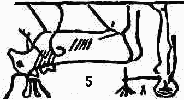
Is called by the Egyptians Enish-go-on-dosh; this is one of the governing planets also, and is said by the Egyptians to be the Sun, and to borrow its light from Kolob through the medium of Kae-e-vanrash, which is the grand Key, or, in other words, the governing power, which governs fifteen other fixed planets or starts, as also Floeese or the Moon, the Earth and the Sun in their annual revolutions. This planet receives its power through the medium of Kli-flos-is-es, or Hah-ko-kau-beam, the stars represented by numbers 22 and 23, receiving light from the revolutions of Kolob. |
A cow wearing a sun disk and double plumes with a menit-necklace
(symbol of Hathor, Ihet, etc.). This is the cow Ihet mentioned in chapter
162 of the Book of the Dead, which should be drawn on a piece of new papyrus
to make a hypocephalus. Hence this picture of a cow is common to almost
all hypocephali. Ihet is a form of Hathor, a personification
of the original waters from which the whole of creation arose and the one
who gave birth to the sun. She is also connected with Mehweret (Greek Methyr),
another cow goddess who symbolized the sky and is the celestial mother
by whom the sun is reborn each day. The name Mehweret (Mh-wr.t)
means, "Great fullness," i.e., the primeval waters from which Re, the Sun,
first arose. Standing behind the cow is the goddess Wedjat who is holding
a lotus blossom, the symbol of rebirth, here indicating the daily and annual
renewal of the sun.
Joseph Smith's explanation that this is the sun is in agreement with
the Egyptian symbolism. Of various names used here by Joseph, I can find
an equivalent only for Hah-ko-kau-beam, which is recognizable as the Hebrew
ha-kokabim
"the stars." But again as stated above, strange, incomprehensible names
are typical of this class of Egyptian religious documents.
Bonnet notes that along with the sun, the apes are also associated with the stars, or with the moon through Thoth |
The Joseph Smith Hypocephalus Seventeen Years
Later, by Michael D. Rhodes
Hathor Cow by Kerry Shirts "Star-Apes" by Kerry Shirts |
|
|

Represents the earth in its four quarters |
These four standing, mummy-like figures are the four Sons of Horus.
They were the gods of the four quarters of the earth and later came to
be regarded as presiding over the four cardinal points. They also were
guardians of the viscera of the dead, and their images were carved on the
four canopic jars into which the internal organs of the dead were placed.
To the right of these four figures is the name of a god written with a lotus blossom, a lion, and a ram (Egyptian srpt-m3i-sr). These three signs are thought to symbolize the gods of the rising, midday, and setting sun, i.e. Re, Khepri, and Atum. This same god is found in several different passages of the late Egyptian demotic papyrus, which refers to Abraham. Joseph Smith gives no explanation of this hieroglyphic name, but it is clearly associated with Abraham in this ancient document. |
The Joseph Smith Hypocephalus Seventeen Years Later, by Michael D. Rhodes |
|
|
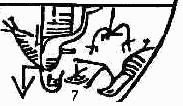
Represents God sitting upon his throne, revealing through the heavens the grand Key-words of the Priesthood; as, also, the sign of the Holy Ghost unto Abraham, in the form of a dove. |
A seated ithyphallic god with a hawk's tail, holding aloft a flail.
This is a form of Min, the god of the regenerative, procreative forces
of nature, perhaps combined with Horus, as the hawk's tail would seem to
indicate. Before the god is what appears to be a bird presenting him with
a Wedjat-eye, the symbol of all good gifts. In other hypocephali it can
also be an ape, a snake, or a hawk-headed snake that is presenting the
eye. This figure represents Nehebka, a snake god and one of the judges
of the dead in the 125th chapter of the Book of the Dead. Nehebka
was considered to be a provider of life and nourishment, and as such was
often shown presenting a pair of jars or a Wedjat-eye. As for the bird
found in Facsimile 2, this could symbolize the Ba or soul (which the Egyptians
often represented as a bird) presenting the Wedjat-eye to the seated god.
The connection of the Wedjat-eye with "the grand key-words of the priesthood" was discussed above. The Egyptians commonly portrayed the soul or spirit as a bird, so a bird is an appropriate symbol for the Holy Ghost. |
The Joseph Smith Hypocephalus Seventeen Years Later, by Michael D. Rhodes |
|
|
Contains writings that cannot be revealed unto the world; but is to be had in the Holy Temple of God. | Stressing the secrecy of these things is entirely in harmony with Egyptian religious documents such as the hypocephalus and the 162nd chapter of the Book of the Dead. For example, we read in the 162nd chapter of the Book of the Dead, "This is a great and secret book. Do not allow anyone's eyes to see it!" Line 8 reads, "Grant that the soul of the Osiris, Shishaq, may live (eternally)." Since the designated purpose of the hypocephalus was to make the deceased divine, it is not unreasonable to see here a reference to the sacred ordinances performed in our Latter-day temples. | The Joseph Smith Hypocephalus Seventeen Years Later, by Michael D. Rhodes |
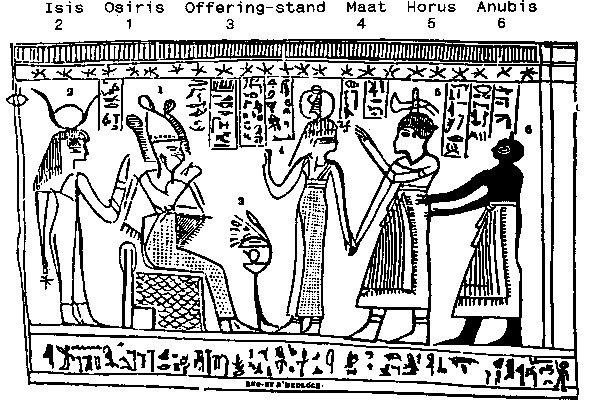
|
|
|
|
|
|
|
Abraham sitting upon Pharaoh's throne, by the politeness of the king, with a crown upon his head. representing the Priesthood, as emblematical of the grand Presidency in Heaven; with the scepter of justice and judgment in his hand. | ||
|
|
King Pharaoh, whose name is given in the characters above his head. | ||
|
|
Signifies Abraham in Egypt--referring to Abraham, as given also as fig. 10 in Fac. 1. | ||
|
|
Prince of Pharaoh, King of Egypt, as written above the hand. | ||
|
|
Shulem, one of the king's principal waiters, as represented by the characters above his hand. | ||
|
|
Olimlah, a slave belonging to the prince. | ||
| Abraham is reasoning upon the principles of Astronomy, in the kings court. |